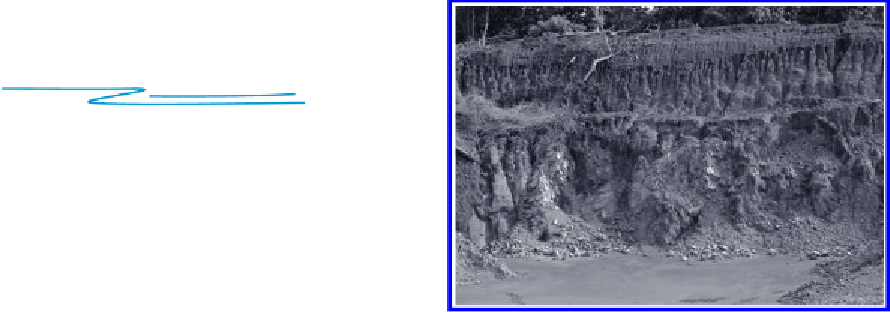Environmental Engineering Reference
In-Depth Information
Raindrop Erosion
Sheet Erosion
Rill Erosion
Gully Erosion
Stream and Channel Erosion
FIGURE 20.1
The Various Forms of Surface Water
Erosion Illustrated
Vegetative cover shields the soil surface from the impact of falling rain, slows the velo-
city of runoff, holds soil in place and maintains the capacity of the soil to absorb water (Day
2000; Goldman
et al
. 1986). It also helps to protect the soil from drying out. Therefore,
the loss of protective vegetative cover increases the erosive impact of both raindrops and
runoff.
Potential targets of signii cant erosion are any areas with changes to natural topography,
and any cleared land surface, including exploration tracks. Access and haul roads, includ-
ing road embankments and road cuts and i lls, spoil piles, active mine faces, high wall
surfaces, waste rock or overburden dumps, and tailings storage areas, including impound-
ment structures are especially susceptible to erosion.
Source:
based on SCS 1980
The Controlling Factors
The widely accepted universal soil loss equation (USLE, US Department of Agriculture
1980) relates average soil loss to i ve factors: rainfall and runoff (R), soil erodibility (K), a
combined slope length and steepness factor (LS), vegetative ground cover and cover man-
agement (C), and support practices (P) (
Figure 20.2
)
. It is an empirical equation that cal-
culates an estimate of soil loss as the numerical product of these i ve empirical factors. The
resulting estimate of soil loss in tonnes per hectare per year is based on average rainfall
conditions. It was developed to predict soil loss for sheet and rill erosion, not for more
concentrated l ow in gullies or channels, which may result in larger volumes of eroded
soil than predicted by the USLE.
While the USLE has limitations, it provides a good basis for considering the factors
that are important for understanding and minimizing erosion. These factors are discussed
below.
Rainfall and Runoff (R)
The force of impact of raindrops on unprotected soil initiates erosion by dislodging parti-
cles, while overland l ow or runoff can both dislodge and carry soil particles down-slope.
Technically, the rainfall and runoff factor, R, combines both a rainfall energy component
and a rainfall intensity factor into one number which is calculated by i rst selecting an aver-
age rainfall year. Then, for each storm in a particular area during the chosen year, the total
energy is multiplied by the maximum 30-minute rainfall intensity, and the resulting values
for each storm are added together (Day 2000). The intensity of a rainfall event is arguably
the single largest contributing factor to soil loss. Rainfall events of more than 200 mm in
The intensity of a rainfall event
is arguably the single largest
contributing factor to soil loss.
























Search WWH ::

Custom Search